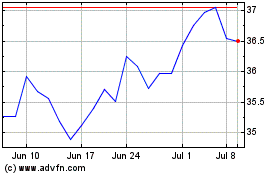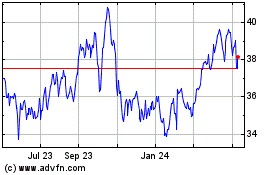Oil Prices Rise 8% on Weak Dollar, Despite Daunting Supply Data
February 03 2016 - 3:57PM
Dow Jones News
By Nicole Friedman
NEW YORK--Oil prices soared on Wednesday, as traders looked past
record-high U.S. crude inventories and focused on the sliding
dollar.
Light, sweet crude for March delivery settled up $2.40, or 8%,
at $32.28 a barrel on the New York Mercantile Exchange. Brent
crude, the global benchmark, rose $2.32, or 7.1%, to $35.04 a
barrel on ICE Futures Europe.
The price gains came despite what otherwise could be bearish
inventory news. The Energy Information Administration reported on
Wednesday that U.S. crude-oil inventories rose 7.8 million barrels
in the week ended Jan. 29 to 502.7 million barrels, the highest
level on record for weekly data going back to 1982. In monthly
data, which don't line up exactly with weekly data, stockpiles last
exceeded 500 million barrels in 1930.
Ample supplies of crude oil and petroleum products around the
world have weighed on oil prices in recent months and sparked
concern among traders that some regions could run out of storage
space.
However, a weaker dollar supported prices. The WSJ Dollar Index,
which tracks the U.S. currency against a basket of other
currencies, recently was down 1.6%. A weaker dollar makes oil,
which is traded in dollars, cheaper for foreign buyers.
"The dollar is sliding rather strongly," said Bob Yawger,
director of the futures division at Mizuho Securities USA Inc. "The
psychological blow that you take from 500 million [barrels] is
significant, [but] it didn't crush the market."
An improvement in Chinese services activity also lent support to
prices. The Caixin China services purchasing managers index rose to
52.4 in January, from 50.2 in December, Caixin Media Co. and
research firm Markit said on Wednesday, pointing to a recovery
outside the factory sector.
China consumes around 12% of the world's crude, second only to
the U.S., and market participants have closely watched the
country's economy to gauge the pace of future demand growth.
Current U.S. domestic commercial crude inventories represent
31.5 days of supply, the highest level since 1984, according to the
EIA. Since mid-1982, the U.S. has held an average of 23.8 days of
supply in storage, not including strategic reserves.
Crude inventories typically rise at this time of year as
refineries buy less crude while performing seasonal maintenance.
"Even though [the crude inventory build] was a shocking number, I
think a lot of people...knew a big build was coming," said Phil
Flynn, analyst at Price Futures Group.
Some traders are looking past ample supplies in the near-term
because they expect low oil prices to lead to less production later
this year, he said. Companies have announced substantial budget
cuts in the past two weeks.
"We're at the price level where the damage has been done to the
production side so dramatically," Mr. Flynn said. "People are
starting to look ahead to the possibility that the market's going
to get more in balance going forward."
The EIA also reported that gasoline supplies rose more than
expected, and distillates, including heating oil and diesel fuel,
fell less than expected. Refinery utilization unexpectedly
declined.
Gasoline futures settled up 1.29 cents, or 1.3%, at $1.0137 a
gallon. Diesel futures rose 6.77 cents, or 6.7%, to $1.0786 a
gallon.
Crude stockpiles in Cushing, Okla., an important storage hub and
the delivery point for Nymex futures, rose by 800,000 barrels to
64.2 million barrels.
U.S. crude-oil production in the lower 48 states was unchanged
from the previous week.
Write to Nicole Friedman at nicole.friedman@wsj.com
(END) Dow Jones Newswires
February 03, 2016 15:42 ET (20:42 GMT)
Copyright (c) 2016 Dow Jones & Company, Inc.
BP (NYSE:BP)
Historical Stock Chart
From Mar 2024 to Apr 2024

BP (NYSE:BP)
Historical Stock Chart
From Apr 2023 to Apr 2024
